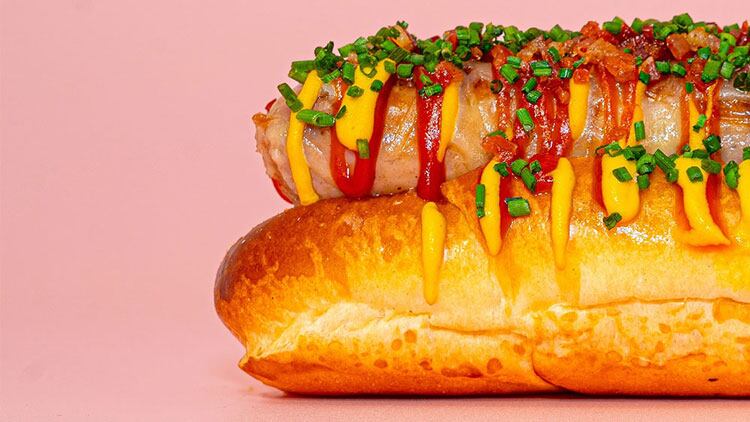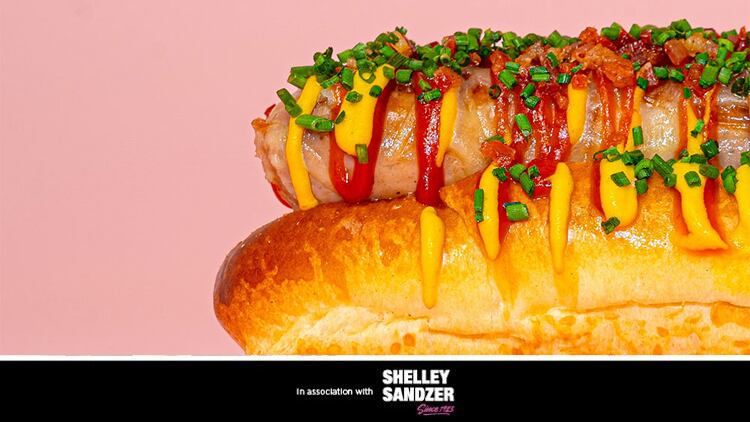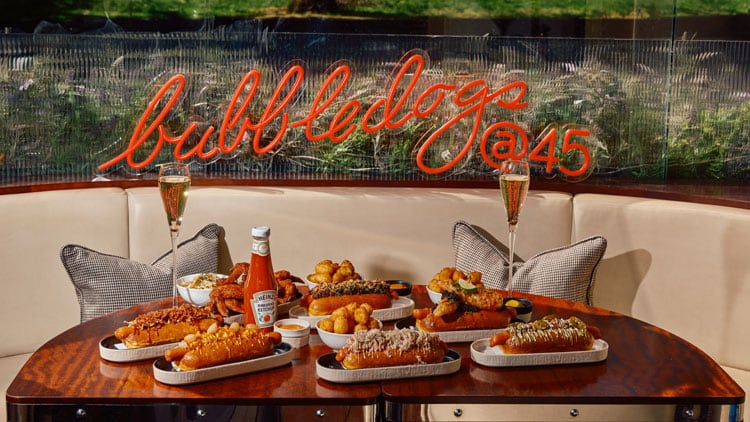The gourmet hot dog is having a moment, and not for the first time. Earlier this year saw the return of Sandia Chang and James Knappett’s Bubbledogs to more salubrious digs within Mayfair’s 45 Park Lane for a summer-long pop-up, and fellow Michelin star chef Jason Atherton is getting in on the act in an equally luxe location.
Early next month the Pollen Street Social founder will open Hot Dogs by Three Darlings at Harrods Dining Hall (Three Darlings being a reference to his upcoming Chelsea bistro), a 25-seat restaurant in the Knightsbridge department store serving a range of five gourmet hot dogs inspired by flavours from around the world.
Then there’s East Sussex-based chef Isaac Bartlett-Copeland, who has recently launched a pub franchise business called Filthy Dog. And while not hot dog specialists, upcoming openings The Hound pub in Chiswick and Des Gunewardena’s Engel restaurant in The City will also be serving bougie takes on a product most people associate with cinemas and petrol station forecourts. It seems that hot dogs are, well, hot right now.
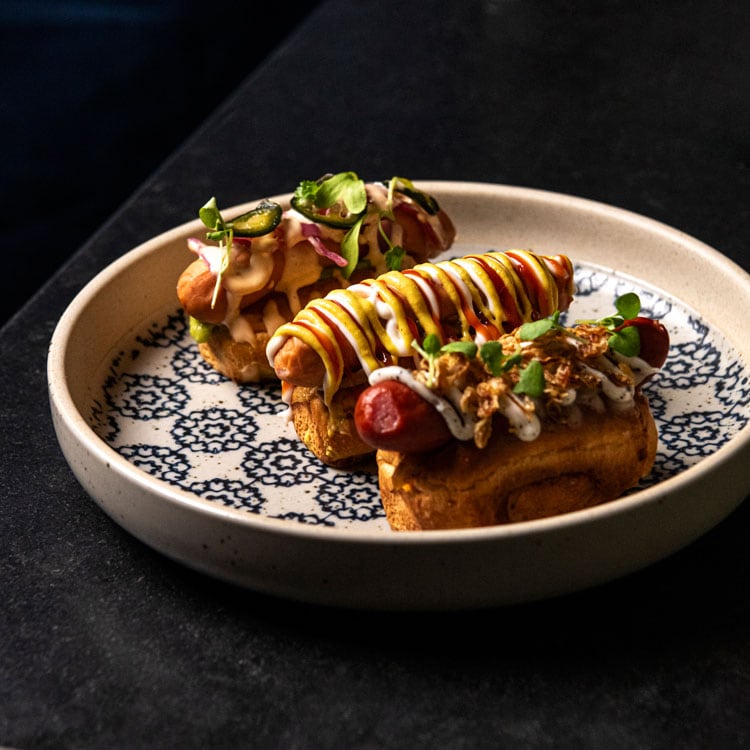
Every dog has its day
If this all seems eerily familiar, then it’s because it is. Go back a decade or so and the hot dog was regarded as the next big thing following the runaway success of the gourmet burger and the rise of street food. The launch of Bubbledogs in Fitzrovia in 2012 kickstarted a flurry of concepts developed with scalability in mind including Top Dog in Soho and Dog Eat Dog in Islington as well as a hot dog and craft beer venture from BrewDog. In 2013 Time Out described the past 12 months as the ‘year of the dog’ such was the hype behind the dish, which has its roots in Germany but is now most associated with the east coast of the US.
“I’m confident there’s a gap in the market
for something that’s higher quality”
Fast forward to today and, apart from the temporary Bubbledogs, none have survived. In the intervening years others have also come and gone, including the short-lived Rockadollar Dogs, opened by former Hawksmoor chef Richard Sandiford, which featured options such as the onglet bulgogi beef dog with onglet steak, chilli, ginger, kewpie mayo, fried onion and micro coriander; and the Yakisoba, a pork dog with pulled pork, lime fennel and fresh slaw with yakisoba sauce and kewpie mayo.
The team behind Tóu by TĀTĀ Eatery even threw their hat into the ring with their Tóu Dog, a hot dog version of its Instafamous katsu sando. Yet unlike another US export, the burger, the hot dog has largely failed to capture the imagination of the restaurant-going public. So, what’s different this time round?
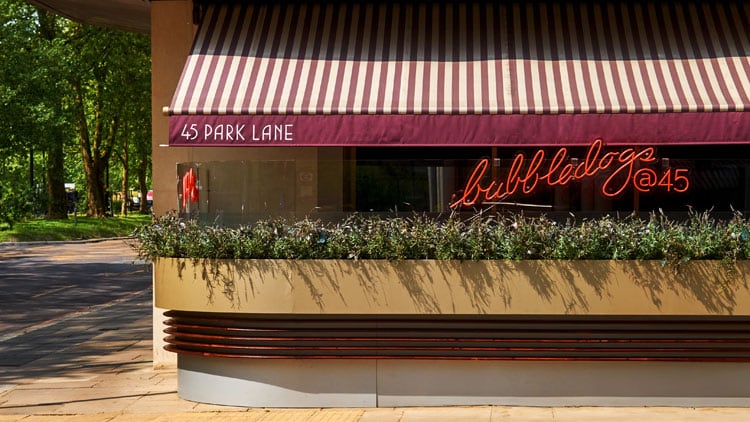
Not letting sleeping dogs lie
Bartlett-Copeland, who is best known for his time behind the stove at Brighton fine dining restaurant Isaac At, acknowledges that the category is not without its challenges. “The problem is that hot dogs are perceived as being something that’s cheap and not worth getting excited about,” he says.
However, like Atherton, he can’t seem to let sleeping dogs lie and believes there is still scope for the hot dog to follow in the footsteps of the burger. “In my research for Filthy Dog I found people thought much the same about the burger not so long ago,” he adds. “I’m confident there’s a gap in the market for something that’s higher quality.”
With Filthy Dog, Bartlett-Copeland has created a menu of around 10 dogs that include the Classic (smoked pork dog, chunky ketchup, house mustard); the Cheese Dog (smoked pork dog, Filthy Dog Cheddar Sauce, Parmesan, pickled and crispy onions); and the Hugh Grant (smoked pork dog, Stilton, Ritz crackers and sage).
He has worked with a local butcher to develop a sausage that sits somewhere between a British banger and a frankfurter. “We use ground meat rather than a paste and we smoke them,” Bartlett-Copeland says. “It’s recognisable as a hot dog sausage but it’s elevated.”
Atherton’s hot dog offer at Harrods will be more elevated still. While details of the menu are still under wraps, the Harrods location suggests a high-end offer that involves truffles and caviar. The core menu at Hot Dogs by Three Darlings will be augmented by a rotating celebrity endorsed hot dog available, with proceeds donated to charity (rumour has it that model David Gandy will be the first to present his dog).
A tough sell
MEATliquor founder Scott Collins has a better understanding of the hot dog’s place in the UK market than most having been serving them since the early days of his US-inspired restaurant brand.
“They can be great but in general they’re not right at the top of people’s wish lists. They work best when they are the only option,” he says.
“For example, Harry’s Bar in Paris only serves hot dogs and they’re brilliant. Same goes for Walt’s Bar in LA (which also majors on hot dogs). There’s an element of headline grabbing from these new gourmet concepts over here, and I think chefs are also looking for menu items that are a bit different and require a low skillset.”
"Hot dogs are at their best
when eaten standing up”
MEATliquor’s hot dogs are high quality but they aren’t gourmet takes. “We do a chilli dog that’s also part of our Triple Chilli Challenge eating competition and there’s also a hot dog on our kid’s menu. We’re looking at introducing a simpler hot dog because chilli dogs aren’t for everyone," continues Collins, who admits that hot dogs have always been a tough sell at his restaurants with burgers outselling them by 15 to one.
"We will probably serve it Chicago style ‘dragged through the garden’ (with garnishes and mustard but – famously – no ketchup). Like most things, hot dogs don’t benefit from being mucked about with."
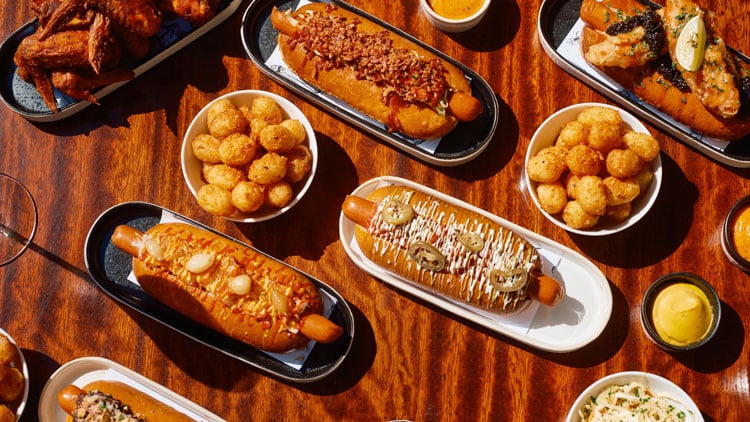
A product best eaten standing up
So will the UK’s appetite for gourmet hot dogs be any more voracious this time round than in previous years? Unlike the gourmet burger category that built on the popularity of standard burgers from McDonald’s et al, hot dogs are less of a thing in the UK (especially when compared to the US, where hot dog carts are found on street corners and the foot long is a match day staple).
Gourmet hot dogs, then, are something of an outlier. The situation is somewhat analogous to tacos: gourmet takes on the category are a harder sell on these shores and have the potential to be misunderstood by diners because of a lack of culture of eating tacos in their original and most accessible form (in the US and Mexico they are a cheap eats staple served up from taco trucks, stands and basic bricks and mortar places).
Indeed, the UK’s obsession with elevating the hot dog could be the very thing that’s holding the category back. On this side of the pond, the product enjoys the most success when served in its purest (and cheapest) form at cinemas, theme parks, petrol stations, stadiums, pubs, and convenience stores. Rarely has it made the crossover onto the restaurant table in the same way that burgers or fried chicken has. As Collins says “hot dogs are at their best when eaten standing up”.
Is 2024 the year of the dog? Time will tell, but recent history suggests the category’s bark is worse than its bite.


